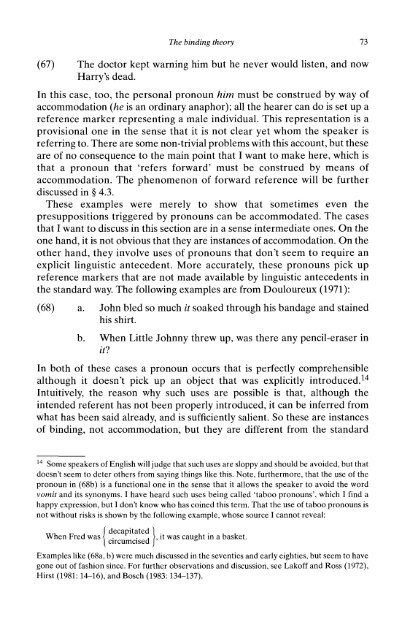Presuppositions and Pronouns - Nijmegen Centre for Semantics
Presuppositions and Pronouns - Nijmegen Centre for Semantics
Presuppositions and Pronouns - Nijmegen Centre for Semantics
Create successful ePaper yourself
Turn your PDF publications into a flip-book with our unique Google optimized e-Paper software.
The binding theory 73<br />
(67) The doctor kept warning him but he never would listen, <strong>and</strong> now<br />
Harry's dead.<br />
In this case, too, the personal pronoun him must be construed by way of<br />
accommodation (he is an ordinary anaphor); all the hearer can do is set up a<br />
reference marker representing a male individual. This representation is a<br />
provisional one in the sense that it is not clear yet whom the speaker is<br />
referring to. There are some non-trivial problems with this account, but these<br />
are of no consequence to the main point that I want to make here, which is<br />
that a pronoun that 'refers <strong>for</strong>ward' must be construed by means of<br />
accommodation. The phenomenon of <strong>for</strong>ward reference will be further<br />
discussed in § 4.3.<br />
These examples were merely to show that sometimes even the<br />
presuppositions triggered by pronouns can be accommodated. The cases<br />
that I want to discuss in this section are in a sense intermediate ones. On the<br />
one h<strong>and</strong>, it is not obvious that they are instances of accommodation. On the<br />
other h<strong>and</strong>, they involve uses of pronouns that don't seem to require an<br />
explicit linguistic antecedent. More accurately, these pronouns pick up<br />
reference markers that are not made available by linguistic antecedents in<br />
the st<strong>and</strong>ard way. The following examples are from Douloureux (1971):<br />
(68) a. John bled so much it soaked through his b<strong>and</strong>age <strong>and</strong> stained<br />
his shirt.<br />
b. When Little Johnny threw up, was there any pencil-eraser in<br />
it it!<br />
In both of these cases a pronoun occurs that is perfectly comprehensible<br />
although it doesn't pick up an object that was explicitly introduced. 14<br />
Intuitively, the reason why such uses are possible is that, although the<br />
intended referent has not been properly introduced, it can be inferred from<br />
what has been said already, <strong>and</strong> is sufficiently salient. So these are instances<br />
of binding, not accommodation, but they are different from the st<strong>and</strong>ard<br />
14 14 Some speakers of English will judge that such uses are sloppy <strong>and</strong> should be avoided, but that<br />
doesn't seem to deter others from saying things like this. Note, furthermore, that the use of the<br />
pronoun in (68b) is a functional one in the sense that it allows the speaker to avoid the word<br />
vomit <strong>and</strong> its synonyms. I have heard such uses being called 'taboo pronouns', which I find a<br />
happy expression, but I don't know who has coined this term. That the use of taboo pronouns is<br />
not without risks is shown by the following example, whose source I cannot reveal:<br />
„,, f decapitated }<br />
When Fred was<br />
{ . . , >, it in [<br />
circumcised deCaPitated} \<br />
,It . was caught<br />
°<br />
m . a basket.<br />
Examples like (68a, b) were much discussed in the seventies <strong>and</strong> early eighties, but seem to have<br />
gone out of fashion since. For further observations <strong>and</strong> discussion, see Lakoff <strong>and</strong> Ross (1972),<br />
Hirst (1981: 14-16), <strong>and</strong> Bosch (1983:134-137). 134-137).














